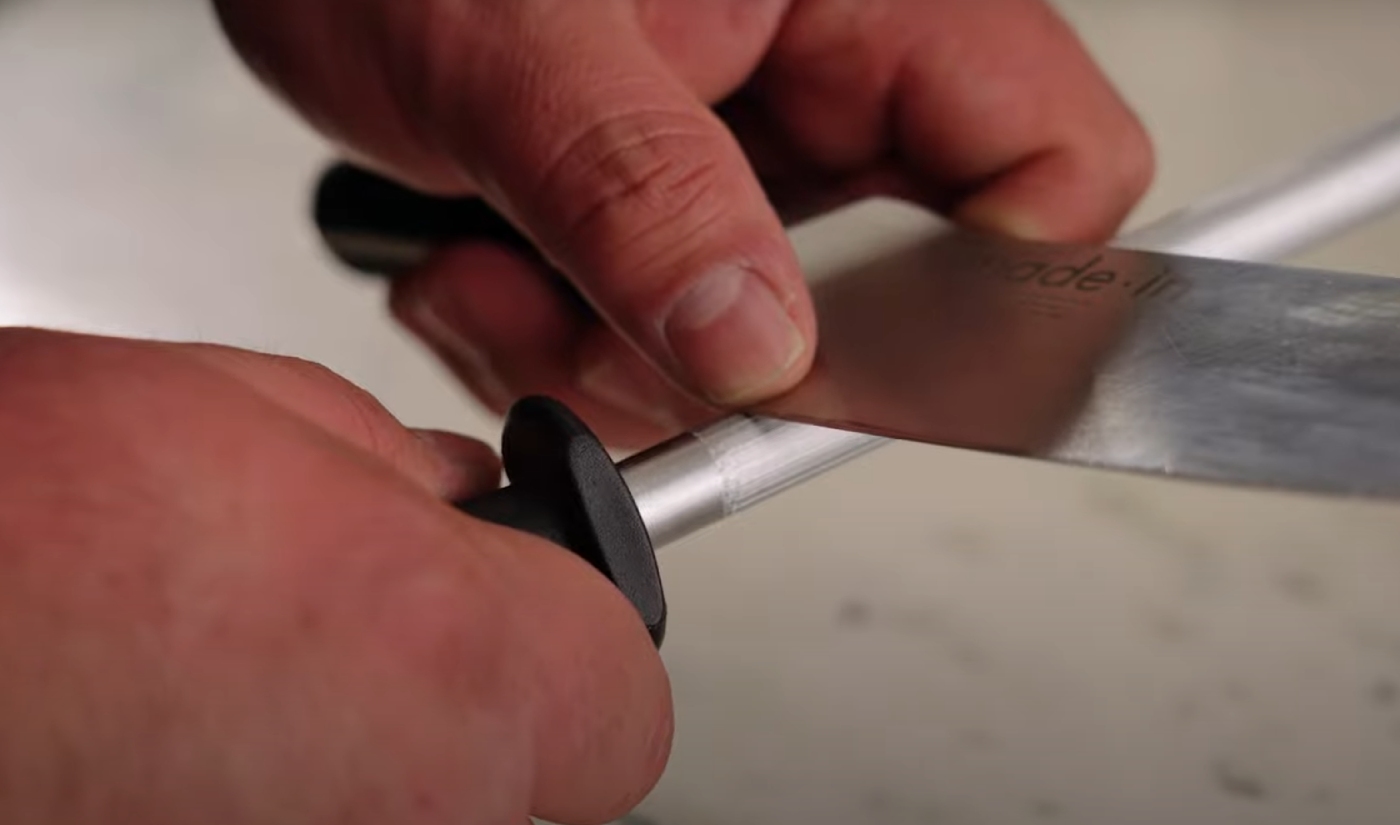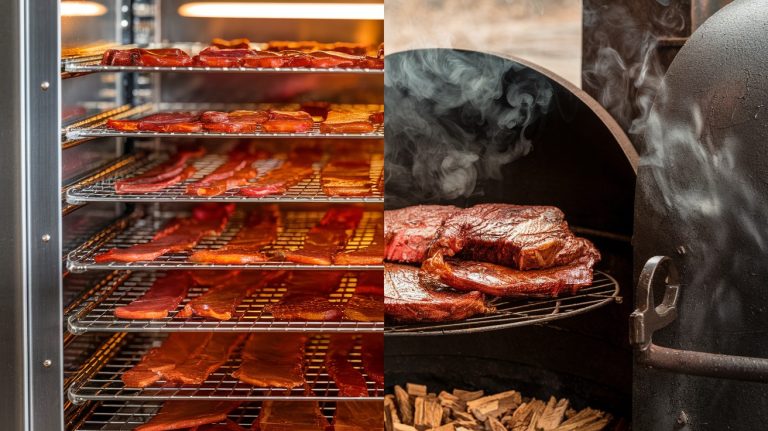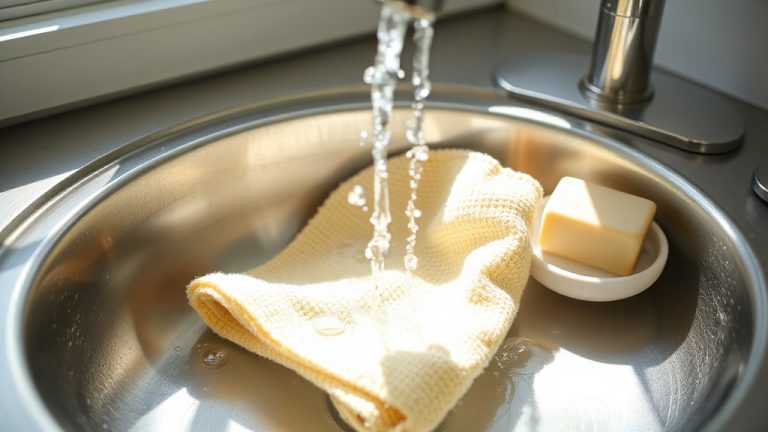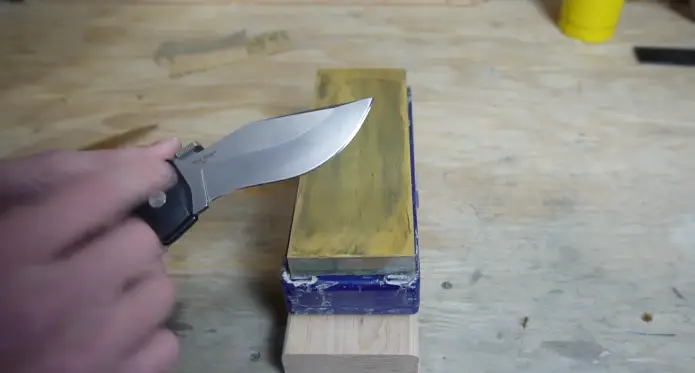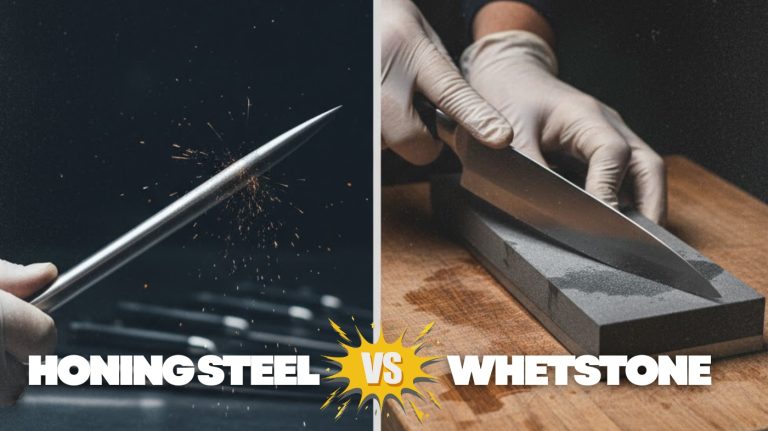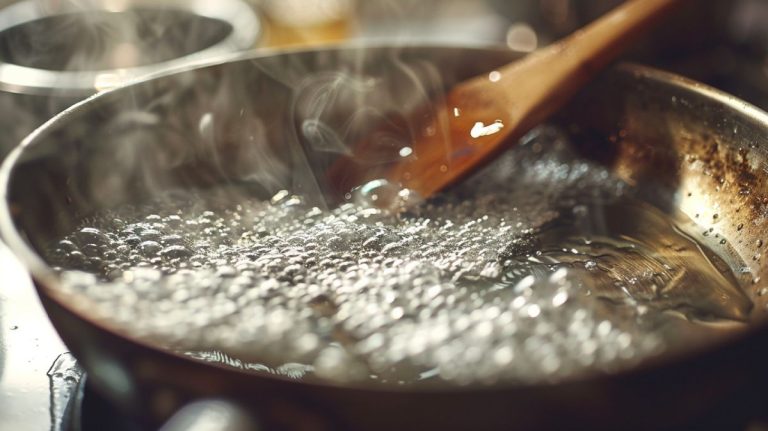How to Use a Honing Steel to Flawlessly Sharpen Your Knives?
To use a honing steel, hold it vertically, resting the tip on a stable surface. Grip the steel with your non-dominant hand and position the knife’s heel against the top at a 15 to 20-degree angle.
With smooth, controlled movements, draw the blade down towards the tip, honing each side 5 to 10 times. Confirm the knife edge faces away from your body for safety.
Regularly honing before and after use helps keep your knives sharp and ready. For peak performance, there’s even more valuable insight about the honing process and maintenance techniques waiting for you.
Key Takeaways
- Hold the honing steel vertically on a stable surface, gripping the handle firmly with your non-dominant hand.
- Position the knife’s heel at a 15 to 20-degree angle against the honing steel’s top.
- Draw the knife’s heel down toward the tip in a smooth motion, honing each side 5 to 10 times.
- Maintain a firm grip and ensure the knife edge is facing away from your body for safety.
- Clean the honing steel with warm soapy water after use and store it safely to avoid injuries.
Proper Positioning Techniques for Using an Honing Steel
To get started with honing your knife effectively, it’s important to position the honing steel correctly. First, hold the honing steel vertically, making sure the tip rests on a stable surface like a cutting board. This stability is vital for a safe honing experience.
Grip the handle firmly with your non-dominant hand while keeping the steel at a safe distance from your body.
Next, position the knife’s heel against the top of the honing steel, angling the blade at approximately 15 to 20 degrees for the best honing. Maintain this angle throughout the process for the finest results.
Here are a few tips to guarantee proper positioning:
- Keep the honing steel secured against the work surface to prevent slipping.
- Position the knife as if you’re about to slice into the steel, which helps maintain the correct angle.
- Focus on moving the knife along the steel, making sure you cover the entire knife edge.
Safety Tips for Honing
You have to prioritize safety when using a honing steel to sharpen your knives. Below are essential safety tips to ensure a secure and effective honing process.
Grip and Stability
A secure grip and stable positioning are essential for safe honing with a honing steel. Always hold the honing steel vertically, ensuring the tip rests firmly on a stable surface like a cutting board. This prevents slipping and enhances your stability during the process.
To maintain ideal control, follow these tips:
- Firm grip: Use your non-dominant hand to hold the honing steel’s handle tightly while keeping your dominant hand on the knife.
- Proper angle: Position the knife’s heel against the top of the honing steel at a 15 to 20-degree angle, adjusting as needed for sharpness and safety.
- Distance: Keep the honing steel at arm’s length from your body to minimize injury risks and maintain a safe distance from your hands.
Slow, Controlled Movements
Maintaining slow, controlled movements is essential for honing your knife safely and effectively. When you use your honing steel, a firm grip on both the steel and knife prevents slips.
High-speed motions increase the risk of cutting yourself, so take your time. Always keep the knife edge facing away from your body and hands to minimize injury risk.
Additionally, position the honing steel securely on a stable surface to enhance your safety. Before starting, check your surroundings for any obstructions or distractions to maintain focus.
Here’s a quick reference to help you understand the importance of slow, controlled movements:
| Tip | Benefit | Result |
|---|---|---|
| Firm grip on tools | Enhances control | Reduces slip risk |
| Slow, deliberate motions | Lowers injury chances | Safer honing process |
| Knife edge away from body | Minimizes accident risk | Increased safety |
| Stable surface | Prevents movement of honing steel | Steady honing |
| Clear surroundings | Maintains focus | Better performance |
Testing Knife Sharpness
When it comes to guaranteeing your knife’s edge is ready for action, testing its sharpness is a simple yet essential step. To do this effectively, grab a sheet of paper.
A sharp knife should slice through it effortlessly without bending or tearing. If you find your knife struggles, or if the cut results in frayed edges, it’s a sign that the blade is dull and may need sharpening.
Here’s a quick reference table to help you evaluate your knife’s sharpness:
| Test Method | Sharp Knife Result | Dull Knife Result |
|---|---|---|
| Paper Test | Clean, straight cut | Frayed edges, tearing |
| Tomato Test | Slices with ease | Squashes instead of cuts |
| Hair Test | Cuts a single hair | No cut, hair remains intact |
| Fingernail Test | Cleanly shaves nail edge | Leaves a rough edge |
| Cardboard Test | Slices through smoothly | Struggles or tears |
Regularly testing knife sharpness after honing sessions guarantees your knife edge remains optimized for food preparation. If dullness persists even after using sharpening steel, consider using sharpening tools or professional services.
Frequency of Honing
Honing your knife frequently is essential for keeping its edge sharp and ready for various cutting tasks. You should aim to use your honing steel before and after each use of the knife to maintain peak sharpness and performance.
By honing each side of the knife 5 to 10 times, you’ll guarantee that it stays ready for any cutting job.
To make the most of your honing routine, consider these tips:
- Hone regularly: Establish a habit of honing your knife every time you use it, guaranteeing it’s always prepared.
- Know when to sharpen: If your knife becomes dull, use a whetstone or sharpening steel before resuming regular honing practices.
- Preserve your knife’s lifespan: Consistent honing helps maintain edge alignment and prevents excessive metal removal, extending the life of your knife.
Cleaning and Maintaining Honing Steel
Regularly cleaning and maintaining your honing steel is essential for ensuring its longevity and effectiveness.
Start by hand washing it with warm soapy water and a soft cloth. This method prevents rust and damage, so avoid using dishwashers that can expose it to excess moisture.
After each use, wipe down your honing steel to remove metal shavings, which helps maintain its performance.
Here are some key maintenance tips to follow:
- Store your honing steel in a safe place, like a magnetic strip or a dedicated drawer, to prevent accidental injuries and protect its surface.
- Inspect the honing steel for signs of wear or rust. If you notice any, use fine sandpaper to restore its smooth surface for peak performance.
- Occasionally, apply a light coat of cooking oil to help prevent rust and maintain its condition.
Frequently Asked Questions
What Is the Proper Way to Use a Honing Steel?
To properly use a honing steel, hold it securely, angle your knife at 20 degrees, and gently pull the blade down from heel to tip. Alternate sides, repeating 5 to 10 strokes for realignment.
How Often Should You Use a Honing Steel?
Think of your knife as a trusted companion. You should hone it before or after each use, ideally 5 to 10 strokes per side. Frequent honing keeps your knife sharp and ready for any culinary adventure.
What Is the Difference Between a Honing Steel and a Sharpening Steel?
A honing steel realigns your knife’s edge without removing material, while a sharpening steel grinds away metal to create a new edge. Regular honing maintains sharpness; sharpening is needed when blades are considerably dull.
Can You Use Your Knife Immediately After Honing?
Yes, you can use your knife immediately after honing it. Honing realigns the edge without removing material, so your knife’s ready for cutting tasks right away. A quick sharpness test guarantees it’s performing at its best.
Sharpen Your Knives with Regular Honing and Elevate Your Culinary Skills
Incorporating honing steel into your routine sharpens your skills, maintains your knives, and elevates your cooking experience. Understanding the tool, selecting the right one, and practicing proper techniques will enhance your knife’s performance and longevity.
Remember to test sharpness regularly and clean your tools after use. With consistent honing, your knives will stay sharp, safe, and ready for any culinary challenge.
Keep honing, keep cooking, and enjoy the precision that comes with well-maintained blades.

